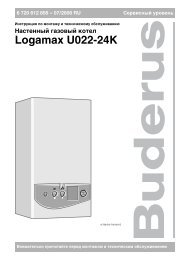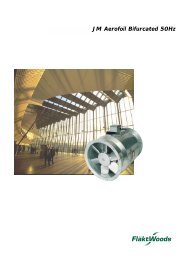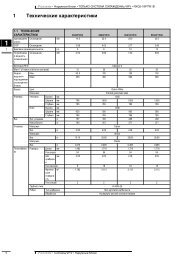FPAC and FPMC axial-<strong>flow</strong> <strong>fan</strong>s Page 8SizingThe charts are applicable to air with a density of 1.2 kg/m³.The pressure/<strong>flow</strong> characteristic of the <strong>fan</strong> is presented as a totalpressure rise ∆pt between the <strong>fan</strong> inlet and the <strong>fan</strong> outlet, providedthat the <strong>fan</strong> is connected to ducting having the same diameter asthat of the <strong>fan</strong>. The charts are applicable to both free inlet <strong>fan</strong>s and<strong>fan</strong>s connected to ducting, and do not include any belt drive loss.The capacities and acoustic data in the charts are based on mesurementsin accordance with the AMCA 210-85 and AMCA 300-85(Air Movement and Control Association Inc.) methods respectively.The connection of the <strong>fan</strong> may vary, depending on the design of theventilation system and the requirements. The outlet side of the <strong>fan</strong>is often connected across a diffuser to a plenum chamber or a duct.Combinations of CD diffuser, air distributor and silencer offer benefitsin terms of space required, low sound level, overall economy, etc.The connection losses for connection cases other than that ofconnection directly to the ducting can be read on the scales at theright-hand bottom.The connection case may be one of the following five:Example of <strong>fan</strong> selectionGiven:A <strong>fan</strong> operating under variable <strong>flow</strong> and pressure conditions with theoutlet connected to a duct across a diffuser (connection case !).Max. air <strong>flow</strong>: 30 m³/s. Normal load: 20-25 m³/s. Static pressure risefrom <strong>fan</strong> inlet to duct: 1200 and 700-850 Pa respectively. Air density:1.2 kg/m³.If compressed air is available for the control, select the FPAC <strong>fan</strong>.Otherwise, select the FPMC with an electric actuator. See page 28for the control force and selection of actuator.Solution:Assume 150 Pa for the dynamic pressure and connection loss,which is added to the required static pressure. From the generalsurvey chart on page 5, a size 125-6 <strong>fan</strong> with a 4-pole motor isselected. The following particulars can be obtained from the <strong>fan</strong>chart for this size.123Dp tDp t Dp 1CDDp t Dp 2CDFan connected directly to a duct.The connection loss is included in the chart.∆pt = ∆ps + pdCD <strong>fan</strong> with an FP(A,M)Z-01 guide vane diffuserconnected to a plenum chamber.∆pt = ∆ps + ∆p1CD <strong>fan</strong> with an FP(A,M)Z-01 guide vane diffuserand FPAZ-05 air distributor connected to a duct.∆pt = ∆ps + ∆p2Operating conditionsFlow m³/s30 25 201) Density ........................................... kg/m³ 1.2 1.2 1.22) Static pressure rise ............................. Pa 1200 850 7003) Speed ............................................... rpm 1470 1470 14704) Dynamic pressure in the duct ............. Pa 130 90 605) Connection loss .................................. Pa 58 40 256) Total pressure rise across the <strong>fan</strong> ...... Pa 1388 980 7857) Blade angle ................................ degrees 47 37 318) Efficiency ............................................. % 81 82 819) Power demand .................................... kW 51.4 29.9 19.410) Suitable motor rating .......................... kW 5511) Max. blade angle ......................... degrees 4812) Total sound power level ................. dB(A) 115 112 10913) Annual operating time ........................... h 250 2000 20004Dp t Dp 3Fan connected to a plenum chamber across aFPAZ diffuser.∆pt = ∆ps + ∆p320000<strong>AXICO</strong> <strong>ANTI</strong>-STALL ® q, m³/h x 100020 40 60 80 100 120 140 160 180FPAC, FPMC 125-6-8n = 1470 rpm5Dp t Dp 4Fan connected to a duct across a FPAZ diffuser.∆pt = ∆ps + ∆p4 + pdD∆pt = total pressure rise across the <strong>fan</strong> (from chart)∆ps = static pressure rise across the installation∆p1, Dp2, Dp3, Dp4 = connection losspd = dynamic pressure in the connected ductpdD = dynamic pressure in the connected duct after diffuserConnection cases "and ! presuppose that the straight section ofduct, downstream of the <strong>fan</strong> or diffuser, has a length of at least 2.5times the nominal diameter of the <strong>fan</strong> or diffuser.The connection loss in an installation with a type FPAZ-04 or FPAZ-05air distributor can be read from the chart on page 7.Two curves showing the dynamic pressure are plotted in the <strong>fan</strong> charts:pd: In a duct with an area corresponding to the nominal diameterof the <strong>fan</strong>, e.g. 1250 mm diameter for a size 125 <strong>fan</strong>.This corresponds to connection case ".pdD: In a duct with an area corresponding to the outlet diameter ofthe FPAZ-03 diffuser. This corresponds to connection case !.D pt , PaP, kWD p , Pa10000002040608020 50808211452°7850°741127045°6511040°10835°10630°18°25°20°10303018° 20° 25° 30°q, m³/s35°40°0 10 20 3040 q, m³/sCD50 100 150 200 300 400 500 600 700D P 1CDJ = 6.1 kg m²ih t= 83%120 L wti 11811645°50°52°50 100 150 200 300 400 500 600PdiPdDiD P 2"!The <strong>fan</strong> charts apply to <strong>fan</strong>s with free inlet as well as to ducted inlet.For arrangement 1 and arrangement 6 <strong>fan</strong>s with FPAZ-21 inlet, adda loss of 0.15 x pd for the protective grille. See also page 11.20 50 100 150 200 250 300 400 5005 10 20 30 40 50100D P 3D P 4
FPAC and FPMC axial-<strong>flow</strong> <strong>fan</strong>s Page 9Sizing (contd.)Annual operating cost:(51.4 x 250 h + 29.9 x 2000 h + 19.4 x 2000 h) x cost per kWh.Items 1 - 13 in the above table are derivated as follows:1, 2) Given3) From the general survey chart (page 5).4) Read from the chart curves for dynamic pressure.The lower curve applies in this example, pdD, since a diffuseris included.5) Read from the <strong>fan</strong> chart scales for the connection loss ∆p4.6) The required static pressure rise, the dynamic pressure plusconnection loss read from the chart.7, 8) Read from the chart - at the intersection of the given <strong>flow</strong> andthe total pressure rise across the <strong>fan</strong>.9) Read from the power chart - at the intersection of the given<strong>flow</strong> and the blade angle. Power is more accurately determinedfrom the expression.Power demand, kW =Flow, m³ x Total pressure rise across the <strong>fan</strong>, Pa10 x Efficiency, %10) The maximum power demand from 9) above is 51.4 kW.Select a 55 kW motor which gives little margin for any increasein <strong>flow</strong> and rise in system resistance in relation to the calculatedvalue. The next larger size of motor may be advisable.11) When delivered from the factory, the <strong>AXICO</strong> <strong>ANTI</strong>-STALL ®is fitted with mechanical stops which limit the blade angle toprevent overloading of the motor. Since the operating conditionsvary from system to system in terms of temperature, densityand system characteristics, the maximum blade angle requiredshould be specified in the order. In the absence of this information,the maximum blade angle will be set to suit the motorrating. For an operating point along the same throttling curve,the maximum blade angle is 48°, since the motor rating islimited to 55 kW.12) Read from the chart - at the intersection of the given <strong>flow</strong> andthe total pressure rise across the <strong>fan</strong>.13) To be specified by the customer.Example of connection casesAs a means of demonstrating the differences in total pressure andpower demand contingent on the connection case selected for agiven system, a comparison between connection cases 1, 2, 3, 4and 5 is presented in the table below.The connection losses have been obtained from the appropriatescale and the dynamic pressure from the appropriate curve in the<strong>fan</strong> chart.Note that different total pressures may give varying <strong>fan</strong> efficiencies,which will affect the overall economy.ControlThe <strong>AXICO</strong> <strong>ANTI</strong>-STALL ® is easily controlled so that it delivers therequired <strong>flow</strong> in all situations. Suitable controllers include pulse controllerswith variable pulse duration and neutral zone, or PI controllerswith a P band of 80% or more. The sensor (transmitter) should beselected so that the controlled variable is approx. 70-90% of themaximum limit of the sensor.The <strong>AXICO</strong> <strong>ANTI</strong>-STALL ® can be adapted to the control signals thatare standard in computerised control systems.FPAC <strong>fan</strong>sN.B. The <strong>fan</strong> includes a diaphragm motor and positioner(see below). Although other (external) control equipment isnot included, it is available as the FPAZ-16 accessory.The blade pitch of the FPAC <strong>fan</strong> can be varied while the <strong>fan</strong> is running.This is done by means of a built-in diaphragm motor which is actuatedby compressed air through a rotary coupling.When the pressure at the diaphragm motor is atmospheric, theblades are in the minimum position, i.e. the <strong>fan</strong> delivers minimumair <strong>flow</strong>.As the pressure at the diaphragm motor increases, the blade anglewill change and the air <strong>flow</strong> through the <strong>fan</strong> will increase.The position of the diaphragm motor is controlled by a linear positionerwhich eliminates hysteresis in controlling the blades, and the bladeangles will therefore change linearly with the input control signal.The positioner is available in two versions: either with a 20-100 Papneumatic control signal or with a 0-20/4-20mA electric control signal.The latter is optional, see accessory FPAZ-14 (and FPAZ-16).In addition, the positioner has one input for the air supply to thediaphragm motor. The air should basically be free from oil, waterand other impurities, i.e. it should be of instrument quality (air thatcontains no particles larger than 10 µm (microns) and has a dewpoint of -20°C or below.For particulars of pressures, see page 28. Pressures above 550 kPa(5.5 atg.) should be avoided.The air demand varies with the number of changes in position andthe magnitudes of the changes. On average, about 0.3 l/s of air ats.t.p. is required. At an operating pressure of 400 kPa, 0.18 l/s of airis required when the positioner is at rest, and about 1.5 l/s of air isneeded for the maximum stroke.FPMC <strong>fan</strong>sThe blades of FPMC <strong>fan</strong>s are turned by linkage system actuated byan external motor. For particulars of control forces and actuators, seethe table on page 28. The actuator must be ordered separately and isavailable as an accessory.External control equipment, see accessory FPMZ-16.Examples of control equipment, see page 10.Connection case 1 2 3 4 5Flow ............................. m³/s 25 25 25 25 25Static pressure rise ........ Pa 850 850 850 850 850Dynamic pressure ......... Pa 250 - - - 90Connection loss .............. Pa - 250 190 165 40Total pressure riseacross the <strong>fan</strong> .................. Pa 1100 1100 1040 1015 980Fan output ..................... kW 33 33 32 31 30
















